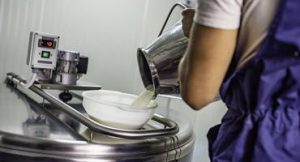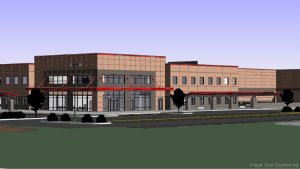
With roughly 325 dairy farms and 700,000 head of dairy cattle statewide, Idaho’s dairy farmers rely on technology more as an enhancement to their rich heritage and farming practices rather than as a savior.
“We’re not The Jetsons,” said Rick Naerebout, CEO of the Idaho Dairymen’s Association (IDA), in reference to the 1960s cartoon that featured a family living a century into the future. “There will never be a day where you can eliminate the human aspect of dairy production.”
Having grown up on a dairy farm in Michigan, and helping to oversee the IDA for the past 22 years, Naerebout knows a thing or two about cows and the dairy business.
“You’re working with a living, breathing creature,” he said. “Technology cannot completely replace the human aspect. But it certainly does help us improve our abilities to manage cattle and to do our jobs better.”

Integrating technology
In Idaho, dairy production still ranks as the No. 1 commodity, with its counterparts in the beef business running a close second. Combined, the two account for about 30% of the Gem State’s total gross domestic product.
“People probably lack an appreciation for as much technology that is used by dairy farmers on a daily basis,” Naerebout said. “And frankly there are a lot more easier ways to make a living than dairy farming.”
In the tiny farming community of Raft River, Idaho, nestled between Burley and American Falls in the southeast part of the state, Josh Webb understands full well the role technology plays on the dairy farm.
“Technology keeps getting better and better,” Webb said. “I don’t know if we will ever eliminate an actual person in farming. There always has to be some brain looking at what is happening.”
As a third-generation farmer, he and his band of brothers operate Heglar Creek Dairy that was originally started by his grandfather in Utah about 130 years ago, and now includes 2,500 head of Holsteins and Jerseys.
And while robotics have played an integral part on the farm for about the past five years, that technology extends far beyond the basics of milking.
“All of our cows have monitoring collars,” Webb said, comparing the device to an Apple watch a human wears. “It tells us activity level, their rumination or eating times, their resting times, and even how many steps the cow is taking in a day.”
“These collars can tell you if the cow has changed her daily activity, which could indicate that she is ready to be bred or ill,” Naerebout said.
Targeted feeding, health monitoring and production figures are all key data points these technological cattle collars provide to farmers.
“When milking, robots can tell the weight of the cow and the temperature of the milk,” Webb said. “If the milk begins getting thick, we suspect mastitis,” a common disease that can cause inflammation of the cow’s mammary glands.

“The robot will flag all those things. It will even dump the milk if it thinks the milk is unhealthy to send for human consumption. We use all those analytics.”
Robotics also play a role in identifying cows that may not be feeling well. Just like a human, if a cow is not eating, which a robot can detect, she is likely ill.
“We treat a cow just as a human,” Naerebout said. “But a cow can’t come to you and say ‘hey, I don’t feel well.’ A human still has to look for visible symptoms that indicate the cow is not feeling well.”
Using technology, a detailed paper trail can be produced on each and every head of cattle.
“We’ve been using electronic medical records for cows for a couple of decades now,” he said. “There are entire software programs dedicated specifically to electronic cow records.”
“When you give a cow medicine, there are then some time periods when the cow’s milk cannot be sold,” Webb said. “If we can catch illness early and detect it through robots, we can treat the cow with more natural alternative methods without having to withhold her milk.”
On average, cows produce milk for about three to five years, but not during their first two years of life. One robot can milk about 60 cows a day, up to three times a day. According to Webb, his herd averages about 90 pounds of fluid milk daily.

“Plus, the robot runs an algorithm that allows cows to milk more frequently if they are considered higher producers,” Webb said. “Some cows are actually milking up to six times a day. The robot essentially allows us to maximize each cow.”
Another benefit of technology is that it allows farmers like Webb to individualize and supplement a cow’s nutritional needs through targeted feeding.
“In the robot barn, I still balance the diet but I’m also able to feed a bit of a supplement into that robot to match the production,” he said.
The technology helps him figure out which cows need a boost to their energy requirement.
“My average milking is 100 pounds per cow per day for a herd,” he said. “I have to build a ration that feeds those cows enough energy to keep giving 100 pounds. Some cows are giving 80 pounds and overeating, but they’re not efficient with their feed. Then there are cows giving 130 pounds but are probably getting shorted nutritiously at some level.”
Best bovine reproduction results
Technology also plays a huge role in producing more cows.
“On the dairy side, technology keeps getting better and better,” Webb said. “At the same time, we work really hard on our genetics. We’re able to sort semen, so when we breed a cow, we know we are getting a heifer. And I’ll get the best heifer out of my best cows.”
For Naerebout, the one downside of technology is the potential for farmers being overwhelmed or inundated with too much data.
“You can also have paralysis by over-analysis by having too many data points,” he said. “But as long as a farmer can sift through it and manage it properly, technology is invaluable.”
While technology continues to enhance the American dairy industry, Webb who obtained a degree in agricultural finance and business at Utah State University, said most people overlook the fact that robotic technology has been a huge part of the dairy industry in Europe for the past 25 years.
“For about the last decade, our farms have been catching up with what is going on in Europe,” Webb said. “It’s not new technology. It’s just new to America, but not new to the world. Europe has historically endured high labor costs.”

Filling employment gaps
And labor is another area in which technology provides a big boost.
According to Webb, because of his farm’s remote location, finding enough workers is a huge problem. These days, he employs about 25 staff members who are provided housing on the farm.
For Webb’s dairy operation, technology plays a huge role in helping to offset the availability of fewer workers to perform essential tasks.
“Trying to fix our labor costs over a set period of time was part of the equation for getting into robotics,” he said. “Our labor expenses increase year over year over year. They never go down or stay the same.”
Educating consumers
However, the one thing that does stay the same and that technology will likely never fix Webb said, is the large number of people who have no idea where their food comes from.
“Most people don’t know, nor do they even typically know a farmer,” he said. “That’s scary to think about.”
As a lifelong veteran of the dairy industry, Naerebout feels people are “clueless,” and any advancements in technology will not clue them in to the fact that a mere 10% of society is responsible for producing food for virtually everyone.
“It’s just a function of the fact that so many people in society are removed from the concept of food production,” he said. “It’s no surprise that so many people are disconnected from what happens on a farm, whether dairy or any other aspect of farming.”
For Webb, “ignorance from the population” is the biggest problem farmers face today.
“I wish the whole world could farm for one year,” he said. “Then they would all appreciate it.”
And to help build some appreciation and knowledge, Webb utilizes an old-school method to help educate anyone who wants to learn how food gets to the market and their homes.
“I open my dairy to any school or group for a tour,” he said. “It’s just as important to me as showing all the technology and cool stuff we use on the farm. I want these visitors to go home and think that when they drink milk, they got to see where it comes from and there is a person or a family behind that milk. Or in my case, 20 families.”
You can now read the most important #news on #eDairyNews #Whatsapp channels!!!
🇺🇸 eDairy News INGLÊS: https://whatsapp.com/channel/0029VaKsjzGDTkJyIN6hcP1K























